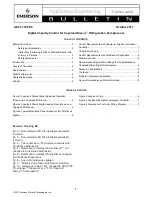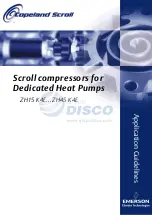
5 – English
SPECIFIC SAFETY RULES
Know your air compressor.
Read operator’s manual
carefully. Learn its applications and limitations, as well
as the specific potential hazards related to this product.
Following this rule will reduce the risk of electric shock,
fire, or serious injury.
Drain tanks of moisture after each day’s use.
If unit will
not be used for a while, it is best to leave drain valve open
until such time as it is to be used. This will allow moisture
to completely drain out and help prevent corrosion on the
inside of tanks.
Risk of Fire or Explosion.
Do not spray flammable liquid
in a confined area. Spray area must be well ventilated. Do
not smoke while spraying or spray where spark or flame
is present. Keep compressors as far from the spraying
area as possible, at least 15 feet from the spraying area
and all explosive vapors.
Risk of Bursting.
Do not adjust regulator to result in
output pressure greater than marked maximum pressure
of attachment. Do not use at pressure greater than 150 psi.
Inspect tanks yearly for rust, pin holes, or other
imperfections that could cause it to become unsafe.
Never weld or drill holes in the air tanks.
Make sure the hose is free of obstructions or snags.
Entangled or snarled hoses can cause loss of balance or
footing and may become damaged.
Use the air compressor only for its intended use. Do
not alter or modify the unit from the original design
or function.
Do not sit or stand on the air compressor frame or
attempt to use the frame as a work surface.
Always be aware that misuse and improper handling of
this product can cause injury to yourself and others.
Never leave a tool unattended with the air hose
attached.
Never point any air tool toward yourself or others.
Do not operate this air compressor if it does not
contain a legible warning label.
Do not continue to use a tool or hose that leaks air or
does not function properly.
Always disconnect the air supply and remove spark
plug wire
before making adjustments, servicing a
product, or when a product is not in use.
Do not attempt to pull or carry the air compressor by
the hose.
Your tool may require more air consumption than this
air compressor is capable of providing.
Always follow all safety rules recommended by the
manufacturer of your air tool, in addition to all safety
rules for the air compressor.
Following this rule will
reduce the risk of serious personal injury.
Never direct a jet of compressed air toward people or
animals. Take care not to blow dust and dirt towards
yourself or others.
Following this rule will reduce the risk
of serious injury.
Do not use this air compressor to spray chemicals.
Your lungs can be damaged by inhaling toxic fumes. A
respirator may be necessary in dusty environments or
when spraying paint. Do not carry while painting.
Inspect hoses periodically and, if damaged, have
repaired at your nearest Qualified Service Center.
Check damaged parts. Before further use of the air
compressor or air tool, a guard or other part that is
damaged should be carefully checked to determine
that it will operate properly and perform its intended
function. Check for alignment of moving parts, binding
of moving parts, breakage of parts, mounting, and
any other conditions that may affect its operation. A
guard or other part that is damaged should be properly
repaired or replaced by a qualified service center.
Following this rule will reduce the risk of shock, fire, or
serious injury.
Never store a tool with air connected.
Storing the tool
with air connected can result in unexpected firing and
possible serious personal injury.
Protect your lungs.
Wear a face or dust mask if the
operation is dusty. Following this rule will reduce the risk
of serious personal injury.
Save these instructions.
Refer to them frequently and use
them to instruct others who may use this product. If you
loan someone this product, loan them these instructions
also.






































